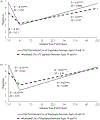Dampened psychobiological responses to stress and substance use in adolescence
- PMID: 35758286
- PMCID: PMC9792637
- DOI: 10.1017/S0954579422000244
Dampened psychobiological responses to stress and substance use in adolescence
Abstract
Substance use increases throughout adolescence, and earlier substance use may increase risk for poorer health. However, limited research has examined whether stress responses relate to adolescent substance use, especially among adolescents from ethnic minority and high-adversity backgrounds. The present study assessed whether blunted emotional and cortisol responses to stress at age 14 related to substance use by ages 14 and 16, and whether associations varied by poverty status and sex. A sample of 277 Mexican-origin youth (53.19% female; 68.35% below the poverty line) completed a social-evaluative stress task, which was culturally adapted for this population, and provided saliva samples and rated their anger, sadness, and happiness throughout the task. They also reported whether they had ever used alcohol, marijuana, cigarettes, and vaping of nicotine at age 14 and again at age 16. Multilevel models suggested that blunted cortisol reactivity to stress was associated with alcohol use by age 14 and vaping nicotine by age 16 among youth above the poverty line. Also, blunted sadness and happiness reactivity to stress was associated with use of marijuana and alcohol among female adolescents. Blunted stress responses may be a risk factor for substance use among youth above the poverty line and female adolescents.
Keywords: adolescence; cortisol; emotion; stress response; substance use.
Conflict of interest statement
Conflicts of Interest: None
Figures






